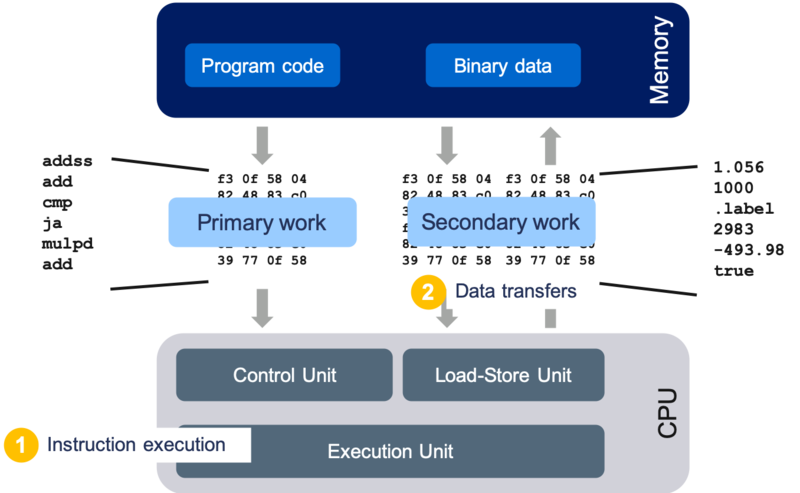Difference between revisions of "Computer architecture for software developers"
(→�) |
(→�) |
||
| Line 1: | Line 1: | ||
== Introduction == | == Introduction == | ||
| − | Modern computers are still build following the "Stored Program Computing" design. The idea for stored program computers originates in the second world war, first working systems where build in the late fourties. A stored program computer is controlled by instructions, the set of instructions a computer supports is also called instruction set architecture (ISA). Instructions are elementary operations as adding two numbers, loading data from memory or jumping to another location in the program code. Instructions are just integer numbers and are stored in a unified memory that also holds the actual data used by a program. A program consists of a sequential stream of instructions loaded from memory that control the hardware. The primary resource of a computer is therefore instruction execution. Some of those instructions load or store data from memory. To transfer data from memory is therefor a secondary resource of a computer triggered by instruction execution. | + | Modern computers are still build following the "Stored Program Computing" design. The idea for stored program computers originates in the second world war, first working systems where build in the late fourties. Several earlier innovations enabled this machine: the idea of a universal Turing machine (1936), Claude E. Shannon's Master thesis on using arrangements of relays to solve Boolean algebra problems. A stored program computer is controlled by instructions, the set of instructions a computer supports is also called instruction set architecture (ISA). Instructions are elementary operations as adding two numbers, loading data from memory or jumping to another location in the program code. Instructions are just integer numbers and are stored in a unified memory that also holds the actual data used by a program. A program consists of a sequential stream of instructions loaded from memory that control the hardware. The primary resource (or work) of a computer is therefore instruction execution. Some of those instructions load or store data from memory. To transfer data from memory is therefor a secondary resource of a computer triggered by instruction execution. |
Illustration of Stored Program Computers: | Illustration of Stored Program Computers: | ||
Revision as of 13:29, 2 July 2019
Introduction
Modern computers are still build following the "Stored Program Computing" design. The idea for stored program computers originates in the second world war, first working systems where build in the late fourties. Several earlier innovations enabled this machine: the idea of a universal Turing machine (1936), Claude E. Shannon's Master thesis on using arrangements of relays to solve Boolean algebra problems. A stored program computer is controlled by instructions, the set of instructions a computer supports is also called instruction set architecture (ISA). Instructions are elementary operations as adding two numbers, loading data from memory or jumping to another location in the program code. Instructions are just integer numbers and are stored in a unified memory that also holds the actual data used by a program. A program consists of a sequential stream of instructions loaded from memory that control the hardware. The primary resource (or work) of a computer is therefore instruction execution. Some of those instructions load or store data from memory. To transfer data from memory is therefor a secondary resource of a computer triggered by instruction execution.
Illustration of Stored Program Computers:
